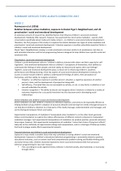Summary
Summary articles - Topic Always Connected 2017
- Course
- Institution
Extensive summary of the articles that were part of the course Topic Always Connected - Key insights in Youth, Media and Technology 2017. Literature list: Bailey, J. O., & Bailenson, J. N. (2017). Considering virtual reality in children’s lives. Journal of Children and Media, 11(1), 107-113. Ba...
[Show more]



